2020 VOLKSWAGEN TIGUAN tow
[x] Cancel search: towPage 215 of 341
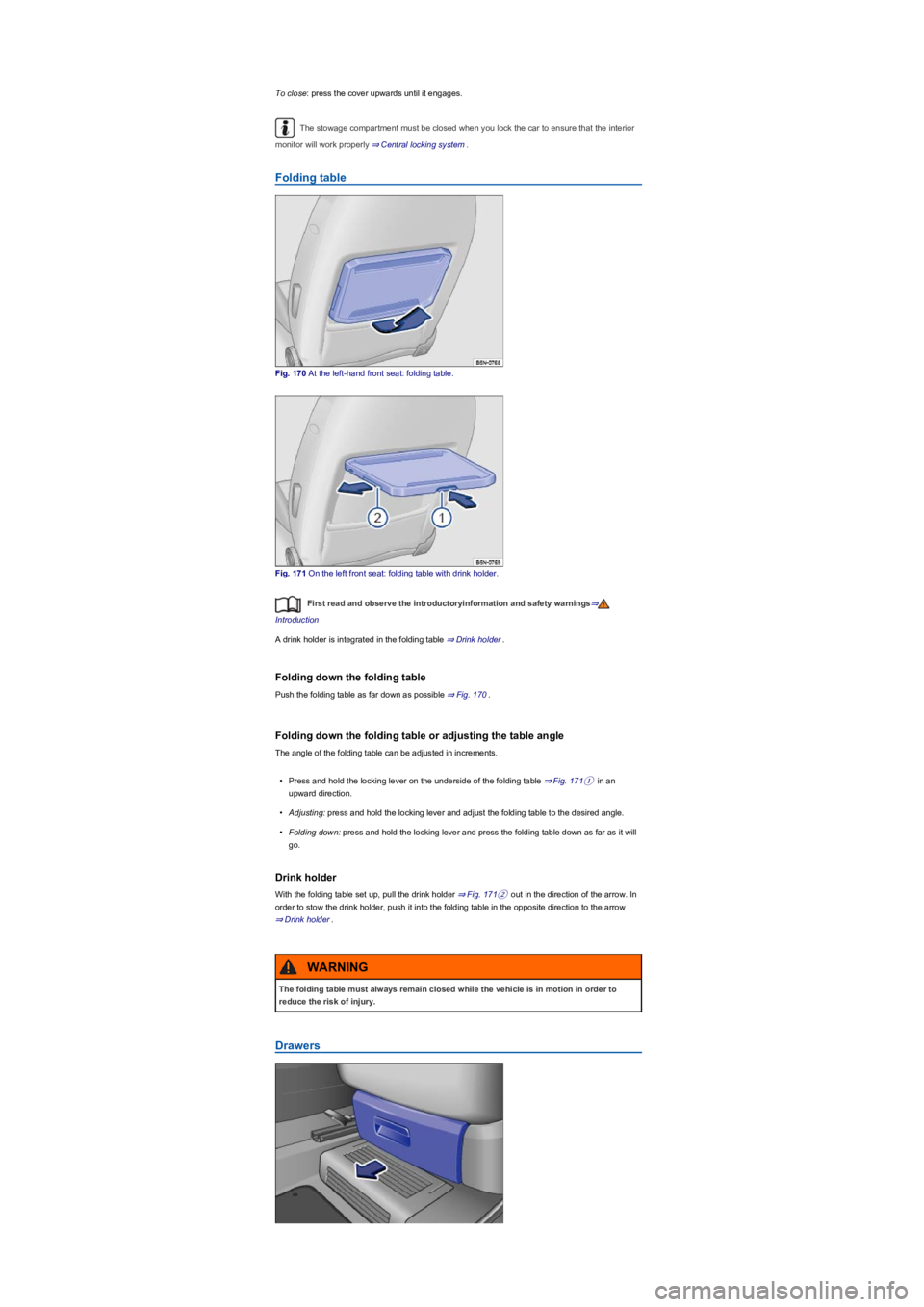
To close: press the cover upwards until it engages.
The stowage compartment must be closed when you lock the car to ensure that the interior
monitor will work properly ⇒ Central locking system.
Folding table
Fig. 170 At the left-hand front seat: folding table.
Fig. 171 On the left front seat: folding table with drink holder.
First read and observe the introductoryinformation and safety warnings⇒
Introduction
A drink holder is integrated in the folding table ⇒ Drink holder.
Folding down the folding table
Push the folding table as far down as possible ⇒ Fig. 170.
Folding down the folding table or adjusting the table angle
The angle of the folding table can be adjusted in increments.
•Press and hold the locking lever on the underside of the folding table ⇒ Fig. 171① in an
upward direction.
•Adjusting: press and hold the locking lever and adjust the folding table to the desired angle.
•Folding down: press and hold the locking lever and press the folding table down as far as it will
go.
Drink holder
With the folding table set up, pull the drink holder ⇒ Fig. 171② out in the direction of the arrow. In
order to stow the drink holder, push it into the folding table in the opposite direction to the arrow
⇒ Drink holder.
Drawers
The folding table must always remain closed while the vehicle is in motion in order to
reduce the risk of injury.
WARNING
Page 216 of 341
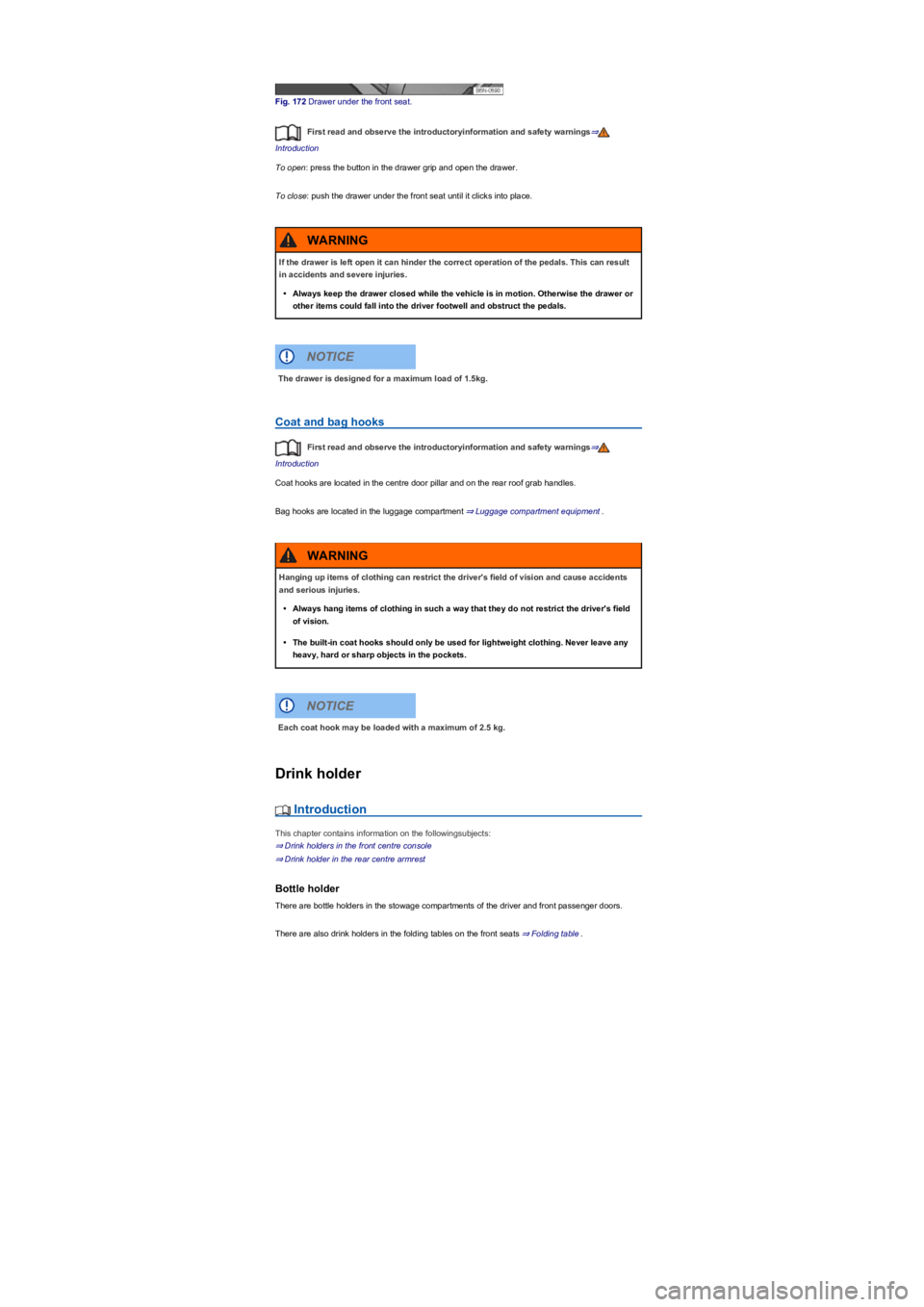
Fig. 172 Drawer under the front seat.
First read and observe the introductoryinformation and safety warnings⇒
Introduction
To open: press the button in the drawer grip and open the drawer.
To close: push the drawer under the front seat until it clicks into place.
Coat and bag hooks
First read and observe the introductoryinformation and safety warnings⇒
Introduction
Coat hooks are located in the centre door pillar and on the rear roof grab handles.
Bag hooks are located in the luggage compartment ⇒ Luggage compartment equipment.
Drink holder
Introduction
This chapter contains information on the followingsubjects:
⇒ Drink holders in the front centre console
⇒ Drink holder in the rear centre armrest
Bottle holder
There are bottle holders in the stowage compartments of the driver and front passenger doors.
There are also drink holders in the folding tables on the front seats ⇒ Folding table.
If the drawer is left open it can hinder the correct operation of the pedals. This can result
in accidents and severe injuries.
•Always keep the drawer closed while the vehicle is in motion. Otherwise the drawer or
other items could fall into the driver footwell and obstruct the pedals.
WARNING
The drawer is designed for a maximum load of 1.5kg.
NOTICE
Hanging up items of clothing can restrict the driver's field of vision and cause accidents
and serious injuries.
•Always hang items of clothing in such a way that they do not restrict the driver's field
of vision.
•The built-in coat hooks should only be used for lightweight clothing. Never leave any
heavy, hard or sharp objects in the pockets.
WARNING
Each coat hook may be loaded with a maximum of 2.5 kg.
NOTICE
Page 219 of 341
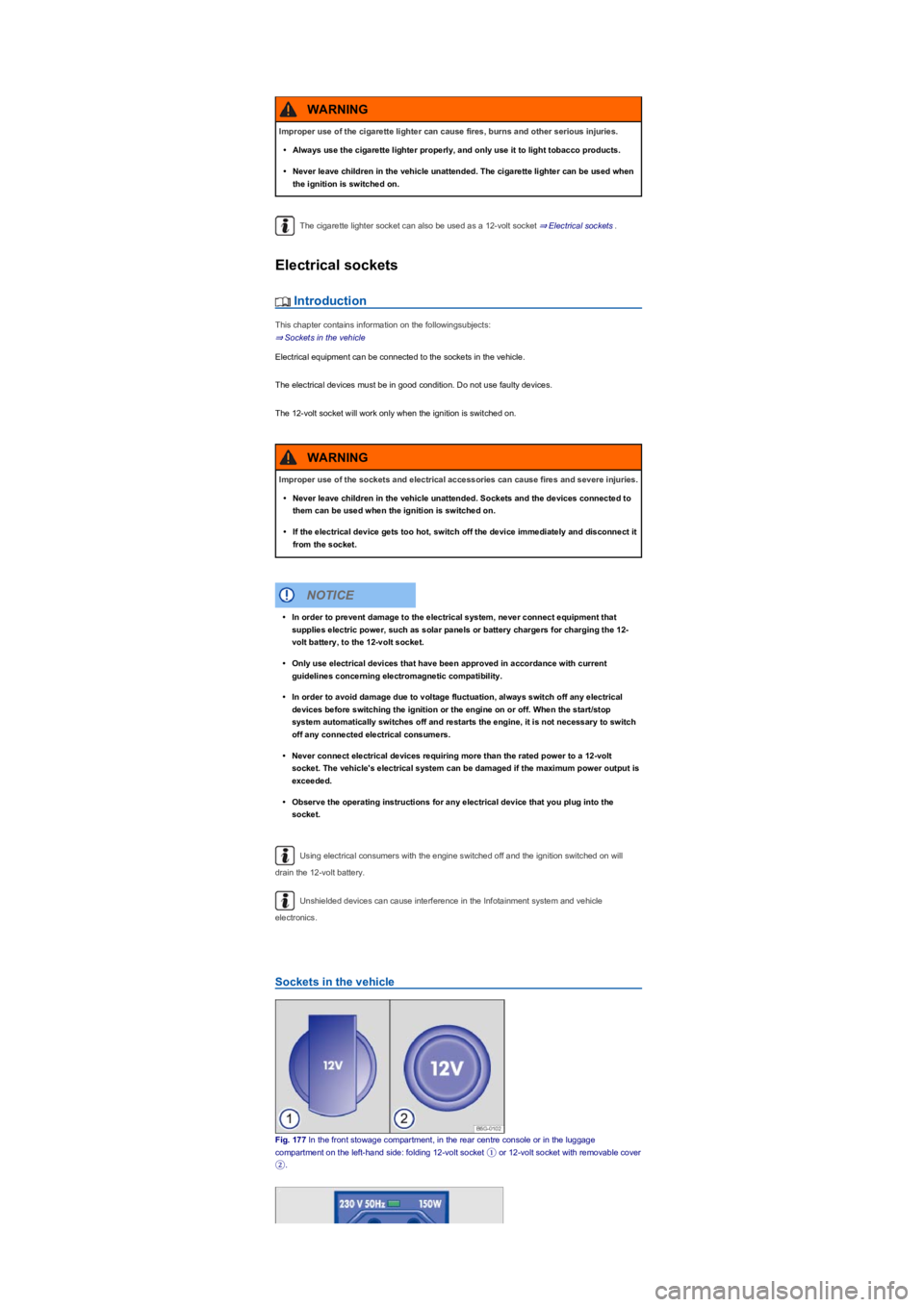
The cigarette lighter socket can also be used as a 12-volt socket ⇒ Electrical sockets.
Electrical sockets
Introduction
This chapter contains information on the followingsubjects:
⇒ Sockets in the vehicle
Electrical equipment can be connected to the sockets in the vehicle.
The electrical devices must be in good condition. Do not use faulty devices.
The 12-volt socket will work only when the ignition is switched on.
Using electrical consumers with the engine switched off and the ignition switched on will
drain the 12-volt battery.
Unshielded devices can cause interference in the Infotainment system and vehicle
electronics.
Sockets in the vehicle
Fig. 177 In the front stowage compartment, in the rear centre console or in the luggage
compartment on the left-hand side: folding 12-volt socket ① or 12-volt socket with removable cover
②.
Improper use of the cigarette lighter can cause fires, burns and other serious injuries.
•Always use the cigarette lighter properly, and only use it to light tobacco products.
•Never leave children in the vehicle unattended. The cigarette lighter can be used when
the ignition is switched on.
WARNING
Improper use of the sockets and electrical accessories can cause fires and severe injuries.
•Never leave children in the vehicle unattended. Sockets and the devices connected to
them can be used when the ignition is switched on.
•If the electrical device gets too hot, switch off the device immediately and disconnect it
from the socket.
WARNING
•In order to prevent damage to the electrical system, never connect equipment that
supplies electric power, such as solar panels or battery chargers for charging the 12-
volt battery, to the 12-volt socket.
•Only use electrical devices that have been approved in accordance with current
guidelines concerning electromagnetic compatibility.
•In order to avoid damage due to voltage fluctuation, always switch off any electrical
devices before switching the ignition or the engine on or off. When the start/stop
system automatically switches off and restarts the engine, it is not necessary to switch
off any connected electrical consumers.
•Never connect electrical devices requiring more than the rated power to a 12-volt
socket. The vehicle's electrical system can be damaged if the maximum power output is
exceeded.
•Observe the operating instructions for any electrical device that you plug into the
socket.
NOTICE
Page 224 of 341
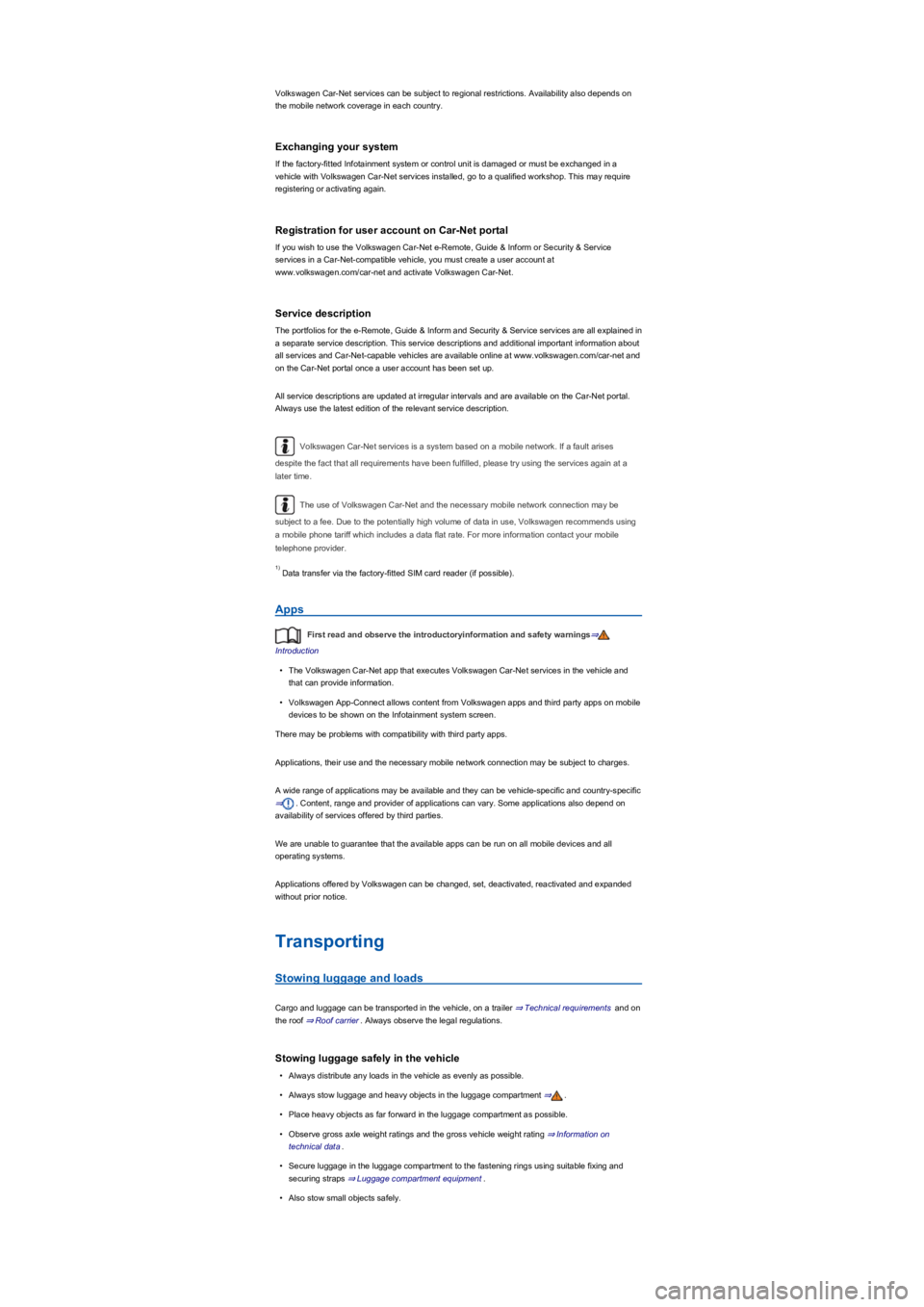
Volkswagen Car-Net services can be subject to regional restrictions. Availability also depends on
the mobile network coverage in each country.
Exchanging your system
If the factory-fitted Infotainment system or control unit is damaged or must be exchanged in a
vehicle with Volkswagen Car-Net services installed, go to a qualified workshop. This may require
registering or activating again.
Registration for user account on Car-Net portal
If you wish to use the Volkswagen Car-Net e-Remote, Guide & Inform or Security & Service
services in a Car-Net-compatible vehicle, you must create a user account at
www.volkswagen.com/car-net and activate Volkswagen Car-Net.
Service description
The portfolios for the e-Remote, Guide & Inform and Security & Service services are all explained in
a separate service description. This service descriptions and additional important information about
all services and Car-Net-capable vehicles are available online at www.volkswagen.com/car-net and
on the Car-Net portal once a user account has been set up.
All service descriptions are updated at irregular intervals and are available on the Car-Net portal.
Always use the latest edition of the relevant service description.
Volkswagen Car-Net services is a system based on a mobile network. If a fault arises
despite the fact that all requirements have been fulfilled, please try using the services again at a
later time.
The use of Volkswagen Car-Net and the necessary mobile network connection may be
subject to a fee. Due to the potentially high volume of data in use, Volkswagen recommends using
a mobile phone tariff which includes a data flat rate. For more information contact your mobile
telephone provider.
Data transfer via the factory-fitted SIM card reader (if possibleyf�.
Apps
First read and observe the introductoryinformation and safety warnings⇒
Introduction
•The Volkswagen Car-Net app that executes Volkswagen Car-Net services in the vehicle and
that can provide information.
•Volkswagen App-Connect allows content from Volkswagen apps and third party apps on mobile
devices to be shown on the Infotainment system screen.
There may be problems with compatibility with third party apps.
Applications, their use and the necessary mobile network connection may be subject to charges.
A wide range of applications may be available and they can be vehicle-specific and country-specific
⇒. Content, range and provider of applications can vary. Some applications also depend on
availability of services offered by third parties.
We are unable to guarantee that the available apps can be run on all mobile devices and all
operating systems.
Applications offered by Volkswagen can be changed, set, deactivated, reactivated and expanded
without prior notice.
Transporting
Stowing luggage and loads
Cargo and luggage can be transported in the vehicle, on a trailer ⇒ Technical requirements and on
the roof ⇒ Roof carrier. Always observe the legal regulations.
Stowing luggage safely in the vehicle
•Always distribute any loads in the vehicle as evenly as possible.
•Always stow luggage and heavy objects in the luggage compartment ⇒.
•Place heavy objects as far forward in the luggage compartment as possible.
•Observe gross axle weight ratings and the gross vehicle weight rating ⇒ Information on
technical data.
•Secure luggage in the luggage compartment to the fastening rings using suitable fixing and
securing straps ⇒ Luggage compartment equipment.
•Also stow small objects safely.
1yf
Page 225 of 341
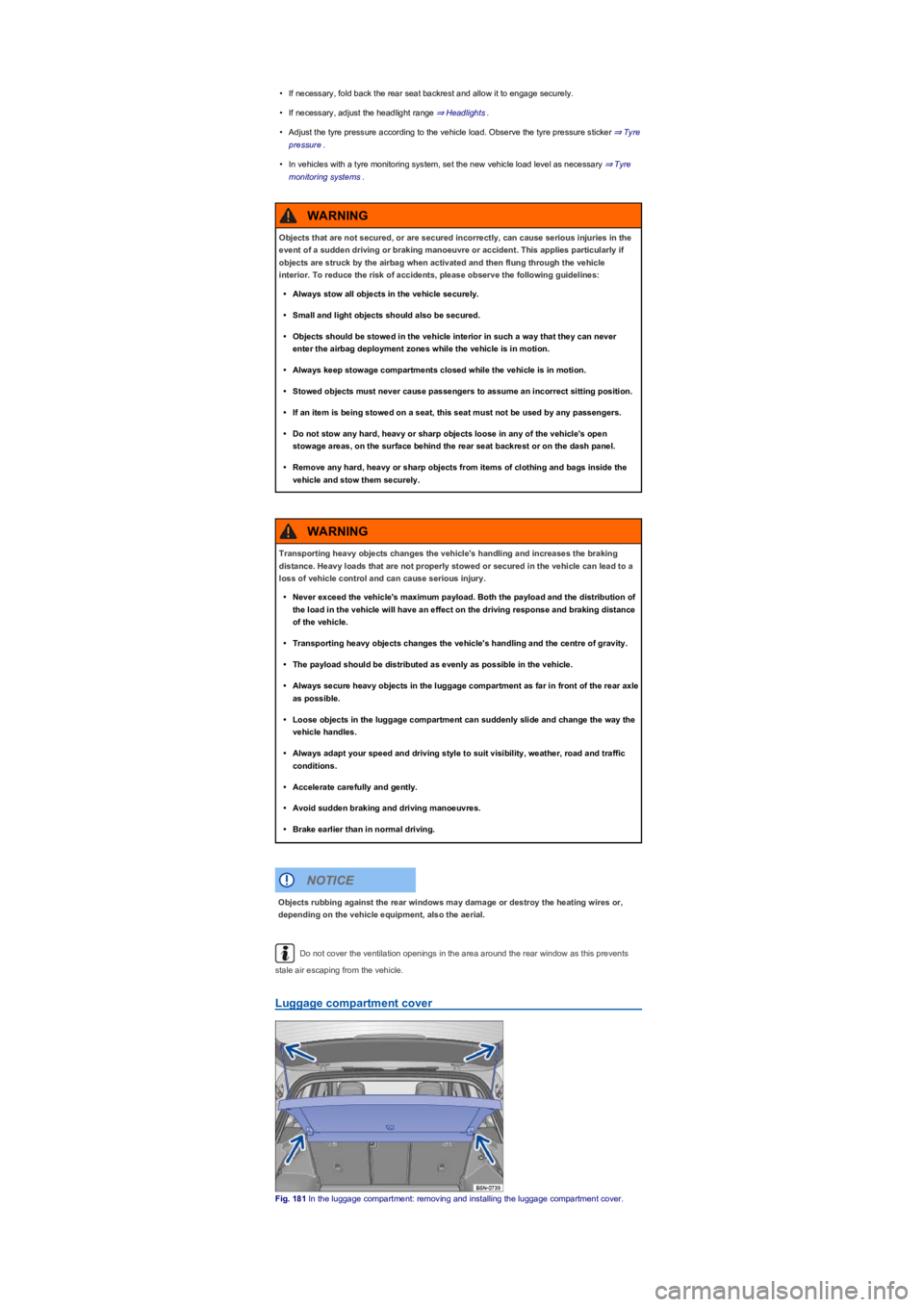
•If necessary, fold back the rear seat backrest and allow it to engage securely.
•If necessary, adjust the headlight range ⇒ Headlights.
•Adjust the tyre pressure according to the vehicle load. Observe the tyre pressure sticker ⇒ Tyre
pressure.
•In vehicles with a tyre monitoring system, set the new vehicle load level as necessary ⇒ Tyre
monitoring systems.
Do not cover the ventilation openings in the area around the rear window as this prevents
stale air escaping from the vehicle.
Luggage compartment cover
Fig. 181 In the luggage compartment: removing and installing the luggage compartment cover.
Objects that are not secured, or are secured incorrectly, can cause serious injuries in the
event of a sudden driving or braking manoeuvre or accident. This applies particularly if
objects are struck by the airbag when activated and then flung through the vehicle
interior. To reduce the risk of accidents, please observe the following guidelines:
•Always stow all objects in the vehicle securely.
•Small and light objects should also be secured.
•Objects should be stowed in the vehicle interior in such a way that they can never
enter the airbag deployment zones while the vehicle is in motion.
•Always keep stowage compartments closed while the vehicle is in motion.
•Stowed objects must never cause passengers to assume an incorrect sitting position.
•If an item is being stowed on a seat, this seat must not be used by any passengers.
•Do not stow any hard, heavy or sharp objects loose in any of the vehicle's open
stowage areas, on the surface behind the rear seat backrest or on the dash panel.
•Remove any hard, heavy or sharp objects from items of clothing and bags inside the
vehicle and stow them securely.
WARNING
Transporting heavy objects changes the vehicle's handling and increases the braking
distance. Heavy loads that are not properly stowed or secured in the vehicle can lead to a
loss of vehicle control and can cause serious injury.
•Never exceed the vehicle's maximum payload. Both the payload and the distribution of
the load in the vehicle will have an effect on the driving response and braking distance
of the vehicle.
•Transporting heavy objects changes the vehicle's handling and the centre of gravity.
•The payload should be distributed as evenly as possible in the vehicle.
•Always secure heavy objects in the luggage compartment as far in front of the rear axle
as possible.
•Loose objects in the luggage compartment can suddenly slide and change the way the
vehicle handles.
•Always adapt your speed and driving style to suit visibility, weather, road and traffic
conditions.
•Accelerate carefully and gently.
•Avoid sudden braking and driving manoeuvres.
•Brake earlier than in normal driving.
WARNING
Objects rubbing against the rear windows may damage or destroy the heating wires or,
depending on the vehicle equipment, also the aerial.
NOTICE
Page 226 of 341
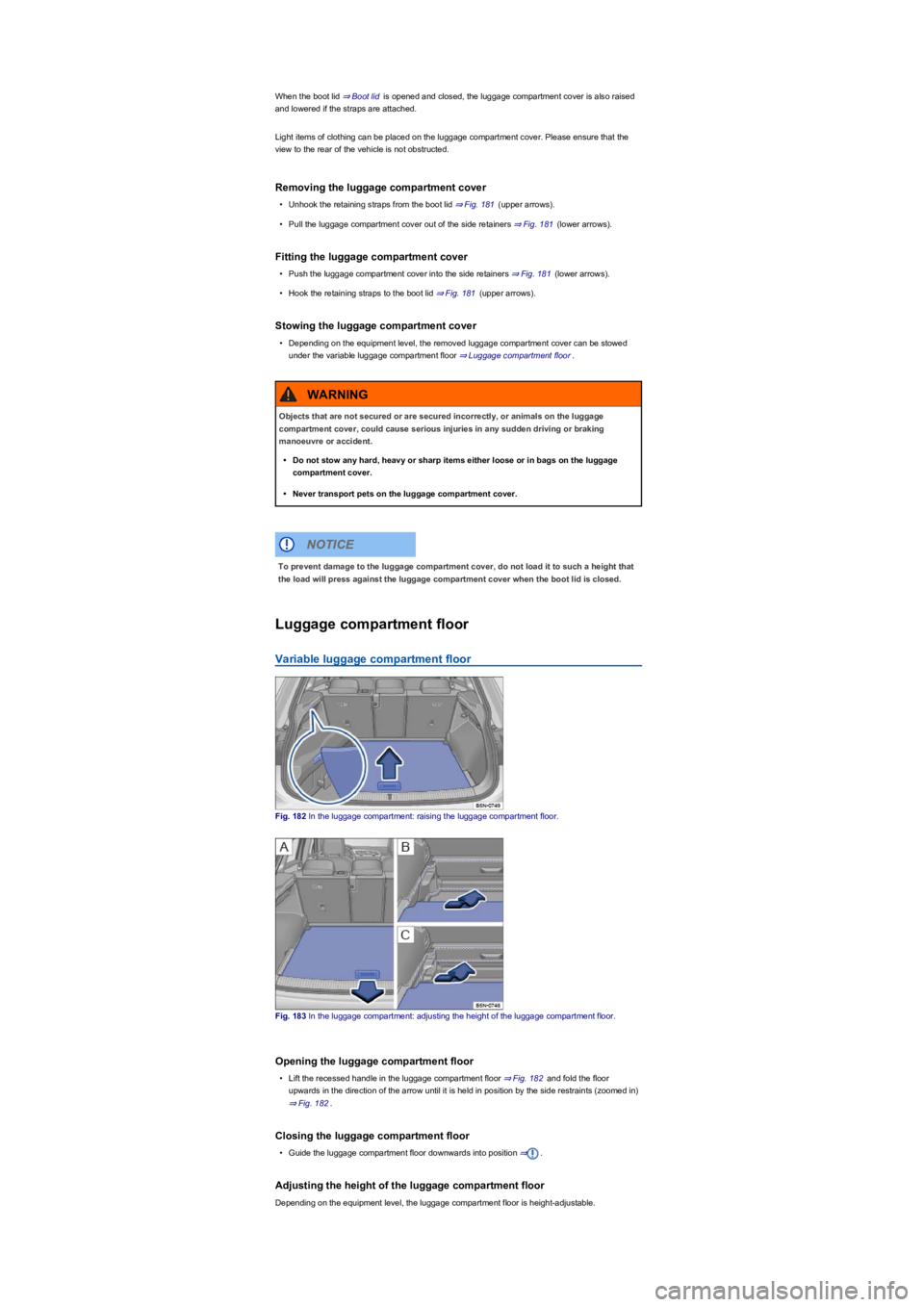
When the boot lid ⇒ Boot lid is opened and closed, the luggage compartment cover is also raised
and lowered if the straps are attached.
Light items of clothing can be placed on the luggage compartment cover. Please ensure that the
view to the rear of the vehicle is not obstructed.
Removing the luggage compartment cover
•Unhook the retaining straps from the boot lid ⇒ Fig. 181 (upper arrowsyf�.
•Pull the luggage compartment cover out of the side retainers ⇒ Fig. 181 (lower arrowsyf�.
Fitting the luggage compartment cover
•Push the luggage compartment cover into the side retainers ⇒ Fig. 181 (lower arrowsyf�.
•Hook the retaining straps to the boot lid ⇒ Fig. 181 (upper arrowsyf�.
Stowing the luggage compartment cover
•Depending on the equipment level, the removed luggage compartment cover can be stowed
under the variable luggage compartment floor ⇒ Luggage compartment floor.
Luggage compartment floor
Variable luggage compartment floor
Fig. 182 In the luggage compartment: raising the luggage compartment floor.
Fig. 183 In the luggage compartment: adjusting the height of the luggage compartment floor.
Opening the luggage compartment floor
•Lift the recessed handle in the luggage compartment floor ⇒ Fig. 182 and fold the floor
upwards in the direction of the arrow until it is held in position by the side restraints (zoomed inyf�
⇒ Fig. 182.
Closing the luggage compartment floor
•Guide the luggage compartment floor downwards into position ⇒.
Adjusting the height of the luggage compartment floor
Depending on the equipment level, the luggage compartment floor is height-adjustable.
Objects that are not secured or are secured incorrectly, or animals on the luggage
compartment cover, could cause serious injuries in any sudden driving or braking
manoeuvre or accident.
•Do not stow any hard, heavy or sharp items either loose or in bags on the luggage
compartment cover.
•Never transport pets on the luggage compartment cover.
WARNING
To prevent damage to the luggage compartment cover, do not load it to such a height that
the load will press against the luggage compartment cover when the boot lid is closed.
NOTICE
Page 227 of 341
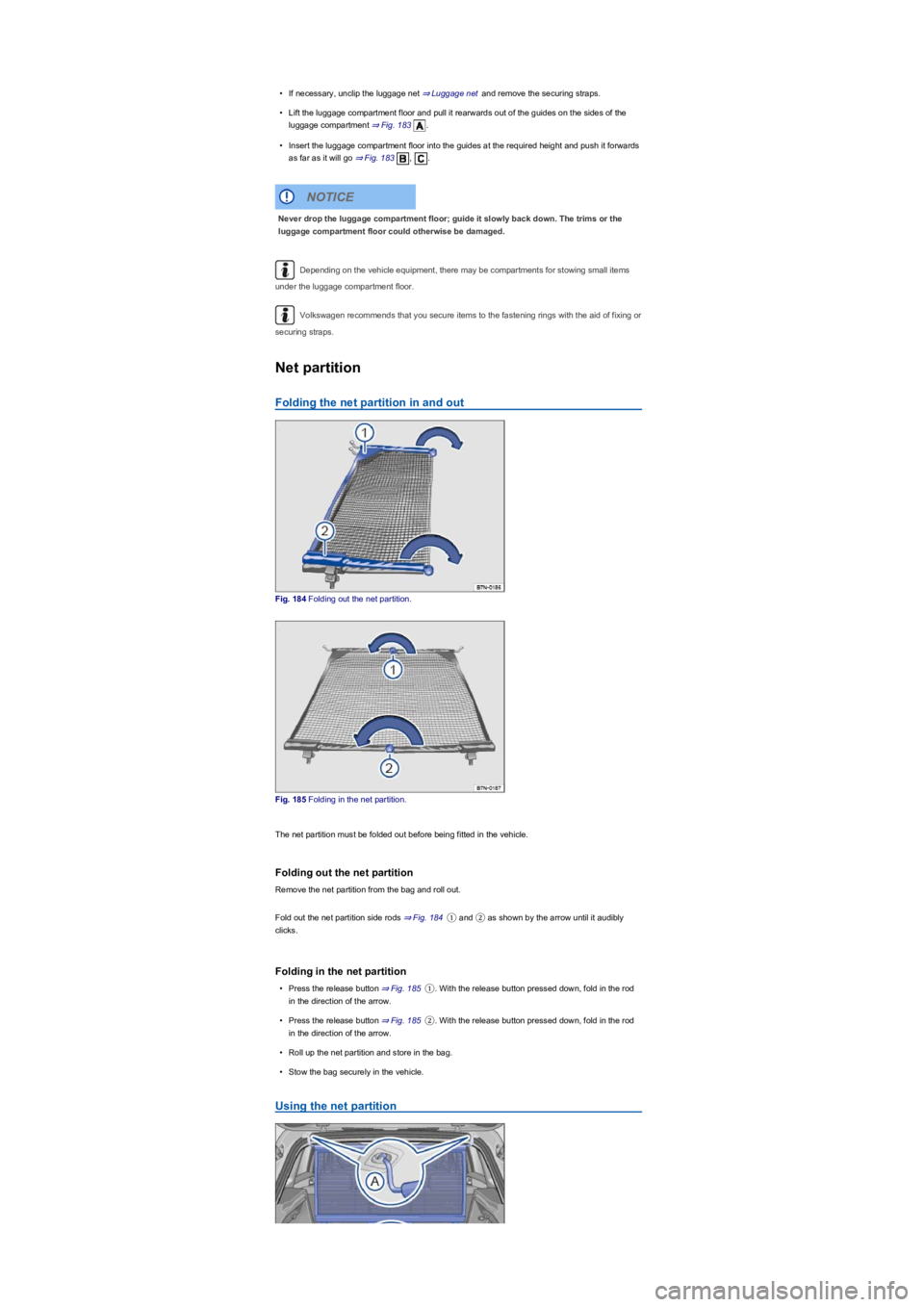
•If necessary, unclip the luggage net ⇒ Luggage net and remove the securing straps.
•Lift the luggage compartment floor and pull it rearwards out of the guides on the sides of the
luggage compartment ⇒ Fig. 183.
•Insert the luggage compartment floor into the guides at the required height and push it forwards
as far as it will go ⇒ Fig. 183, .
Depending on the vehicle equipment, there may be compartments for stowing small items
under the luggage compartment floor.
Volkswagen recommends that you secure items to the fastening rings with the aid of fixing or
securing straps.
Net partition
Folding the net partition in and out
Fig. 184 Folding out the net partition.
Fig. 185 Folding in the net partition.
The net partition must be folded out before being fitted in the vehicle.
Folding out the net partition
Remove the net partition from the bag and roll out.
Fold out the net partition side rods ⇒ Fig. 184① and ② as shown by the arrow until it audibly
clicks.
Folding in the net partition
•Press the release button ⇒ Fig. 185①. With the release button pressed down, fold in the rod
in the direction of the arrow.
•Press the release button ⇒ Fig. 185②. With the release button pressed down, fold in the rod
in the direction of the arrow.
•Roll up the net partition and store in the bag.
•Stow the bag securely in the vehicle.
Using the net partition
Never drop the luggage compartment floor; guide it slowly back down. The trims or the
luggage compartment floor could otherwise be damaged.
NOTICE
Page 229 of 341
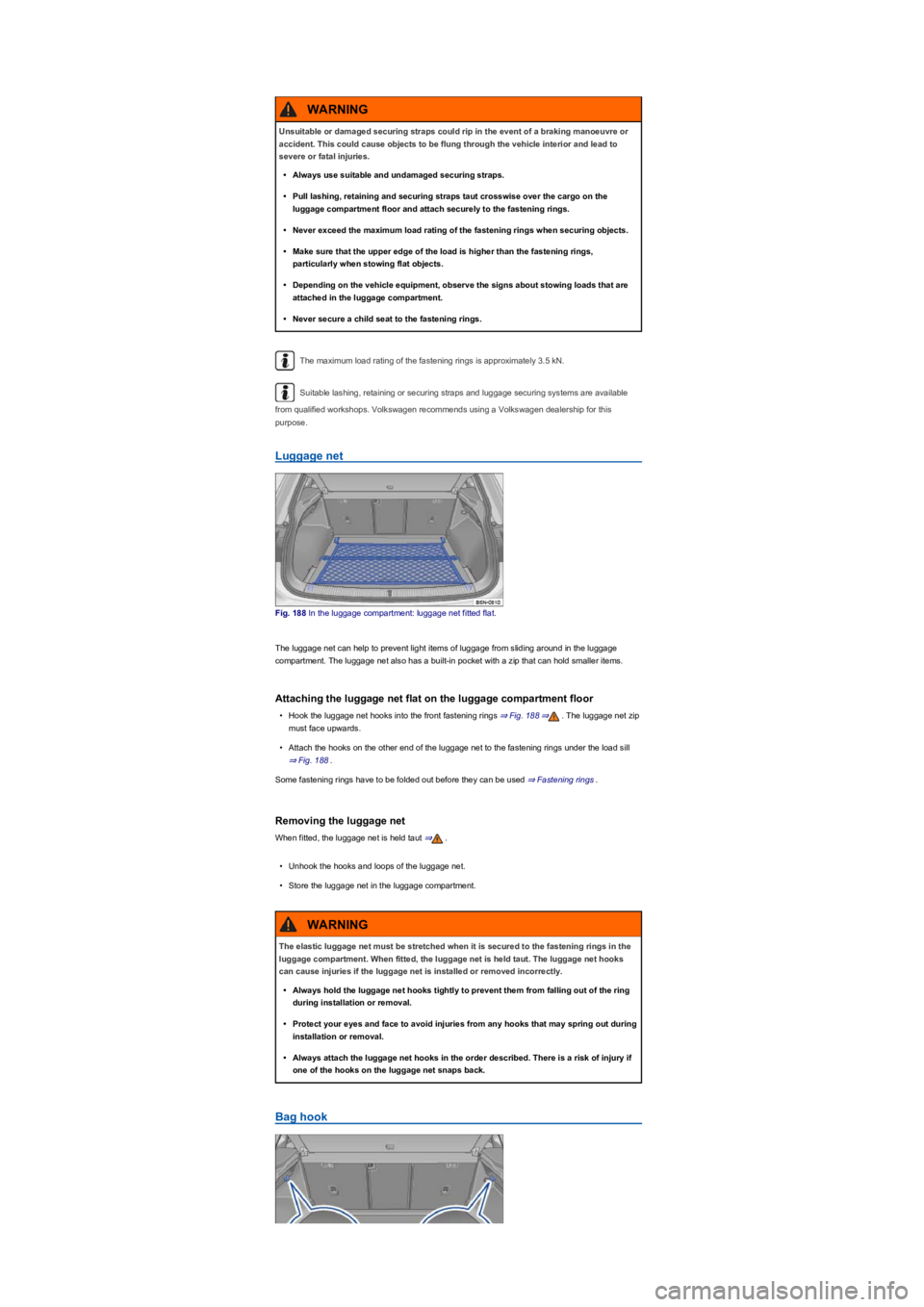
The maximum load rating of the fastening rings is approximately 3.5 kN.
Suitable lashing, retaining or securing straps and luggage securing systems are available
from qualified workshops. Volkswagen recommends using a Volkswagen dealership for this
purpose.
Luggage net
Fig. 188 In the luggage compartment: luggage net fitted flat.
The luggage net can help to prevent light items of luggage from sliding around in the luggage
compartment. The luggage net also has a built-in pocket with a zip that can hold smaller items.
Attaching the luggage net flat on the luggage compartment floor
•Hook the luggage net hooks into the front fastening rings ⇒ Fig. 188⇒. The luggage net zip
must face upwards.
•Attach the hooks on the other end of the luggage net to the fastening rings under the load sill
⇒ Fig. 188.
Some fastening rings have to be folded out before they can be used ⇒ Fastening rings.
Removing the luggage net
When fitted, the luggage net is held taut ⇒.
•Unhook the hooks and loops of the luggage net.
•Store the luggage net in the luggage compartment.
Bag hook
Unsuitable or damaged securing straps could rip in the event of a braking manoeuvre or
accident. This could cause objects to be flung through the vehicle interior and lead to
severe or fatal injuries.
•Always use suitable and undamaged securing straps.
•Pull lashing, retaining and securing straps taut crosswise over the cargo on the
luggage compartment floor and attach securely to the fastening rings.
•Never exceed the maximum load rating of the fastening rings when securing objects.
•Make sure that the upper edge of the load is higher than the fastening rings,
particularly when stowing flat objects.
•Depending on the vehicle equipment, observe the signs about stowing loads that are
attached in the luggage compartment.
•Never secure a child seat to the fastening rings.
WARNING
The elastic luggage net must be stretched when it is secured to the fastening rings in the
luggage compartment. When fitted, the luggage net is held taut. The luggage net hooks
can cause injuries if the luggage net is installed or removed incorrectly.
•Always hold the luggage net hooks tightly to prevent them from falling out of the ring
during installation or removal.
•Protect your eyes and face to avoid injuries from any hooks that may spring out during
installation or removal.
•Always attach the luggage net hooks in the order described. There is a risk of injury if
one of the hooks on the luggage net snaps back.
WARNING